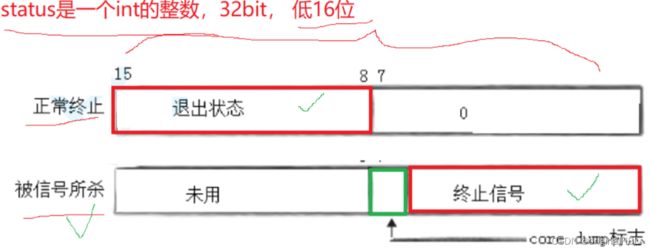Linux中的进程等待(超详细)
Linux中的进程等待
- 1. 进程等待必要性
- 2. 进程等待的方法
-
- 2.1 wait方法
- 2.2 waitpid方法
- 3. 获取子进程status
- 4. 具体代码实现
1. 进程等待必要性
- 我们知道,子进程退出,父进程如果不管不顾,就可能造成‘僵尸进程’的问题,进而造成内存泄漏。
- 另外,进程一旦变成僵尸状态,那就刀枪不入,“杀人不眨眼”的kill -9 也无能为力,因为谁也没有办法杀死一个已经死去的进程。
- 最后,父进程派给子进程的任务完成的如何,我们需要知道。如,子进程运行完成,结果对还是不对,或者是否正常退出。
- 父进程通过进程等待的方式,回收子进程资源,获取子进程退出信息
2. 进程等待的方法
2.1 wait方法
在Linux中,wait函数是一个系统调用,用于等待子进程的终止并获取其终止状态。该函数的原型如下所示:
#includewait函数的作用是暂停当前进程的执行,直到一个子进程终止。当子进程终止后,wait函数会返回子进程的进程ID(PID),并将子进程的终止状态存储在指针status指向的变量中。
status参数是一个指向整型变量的指针,用于存储子进程的终止状态。通过status可以获取子进程的退出状态、终止信号等信息。如果不关心终止状态,可以将status设置为NULL。
wait函数返回的PID有以下几种可能的取值:
- 如果成功等待到一个子进程的终止,返回子进程的PID。
- 如果调用进程没有子进程,wait函数会返回-1
- 如果调用进程被一个信号中断,wait函数会返回-1
1.WIFEXITED(status) 是一个宏,用于判断子进程是否正常退出。当子进程正常退出时,它返回一个非零值。
注意,这里的 status 参数不同于 wait 函数的参数(指向整数的指针),而是指向该指针所指向的整数值。请确保不要混淆它们。
2.WEXITSTATUS(status) 是一个宏,在 WIFEXITED 返回非零值时,用于提取子进程的返回值。例如,如果子进程调用 exit(5) 退出,WEXITSTATUS(status) 将返回 5;如果子进程调用 exit(7),WEXITSTATUS(status) 将返回 7。
请注意,如果进程不是正常退出的,即 WIFEXITED 返回 0,那么 WEXITSTATUS(status) 的值就没有意义。
#include 在上面的示例中,父进程通过fork创建了一个子进程。子进程会执行一段耗时的操作(这里使用sleep模拟),然后退出。父进程调用wait函数等待子进程的终止,并获取子进程的终止状态。最后,父进程继续执行。
2.2 waitpid方法
waitpid函数是Linux中用于等待指定子进程终止的系统调用。与wait函数类似,waitpid函数也可以用于获取子进程的终止状态。
pid_ t waitpid(pid_t pid, int *status, int options);
返回值:
当正常返回的时候waitpid返回收集到的子进程的进程ID;
如果设置了选项WNOHANG,而调用中waitpid发现没有已退出的子进程可收集,则返回0;
如果调用中出错,则返回-1,这时errno会被设置成相应的值以指示错误所在;
参数:
pid:
pid=-1,等待任一个子进程。与wait等效。
pid>0.等待其进程ID与pid相等的子进程。
status:
WIFEXITED(status): 若为正常终止子进程返回的状态,则为真。(查看进程是否是正常退出)
WEXITSTATUS(status): 若WIFEXITED非零,提取子进程退出码。(查看进程的退出码)
options:
WNOHANG: 若pid指定的子进程没有结束,则waitpid()函数返回0,不予以等待。若正常结束,则返回该子进
程的ID,若想使用默认状态,可以将options设成0。
- 如果子进程已经退出,调用wait/waitpid时,wait/waitpid会立即返回,并且释放资源,获得子进程退出信息。
- 如果在任意时刻调用wait/waitpid,子进程存在且正常运行,则进程可能阻塞。
- 如果不存在该子进程,则立即出错返回。
3. 获取子进程status
- wait和waitpid,都有一个status参数,该参数是一个输出型参数,由操作系统填充。
- 如果传递NULL,表示不关心子进程的退出状态信息。
- 否则,操作系统会根据该参数,将子进程的退出信息反馈给父进程。
- status不能简单的当作整形来看待,可以当作位图来看待,具体细节如下图(只研究status低16比特位):

测试代码:
1 #include <sys/wait.h>
2 #include <stdio.h>
3 #include <stdlib.h>
4 #include <string.h>
5 #include <errno.h>
6 #include <unistd.h>
7 int main(void)
8 {
9 pid_t pid;
10 if ((pid = fork()) == -1)
11 perror("fork"), exit(1);
12 if (pid == 0) {
13 printf("pid:%d ppid: %d\n",getpid(),getppid());
14 sleep(20);
15 exit(10);
16 }
17 else {
18 int st;
19 int ret = wait(&st);
20
21 if (ret > 0 && (st & 0X7F) == 0) { // 正常退出
22 printf("child exit code:%d\n", (st >> 8) & 0XFF);
23 }
24 else if (ret > 0) { // 异常退出
25 printf("sig code : %d\n", st & 0X7F);
26 }
27 }
28 }
4. 具体代码实现
- 进程的阻塞等待方式:
#include - 进程的非阻塞等待方式:
#include 



